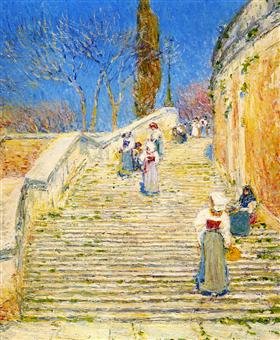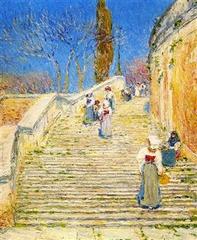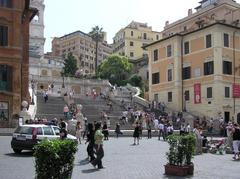
Spanish Steps Rome: Visiting Hours, Tickets, Historical Sites & Preservation Guide
Date: 14/06/2025
Introduction
The Spanish Steps (Scalinata di Trinità dei Monti) are a quintessential symbol of Rome, renowned for their Baroque elegance, cultural importance, and vibrant urban atmosphere. Connecting the lively Piazza di Spagna with the French-owned Trinità dei Monti church, this monumental staircase has long been a magnet for artists, writers, and travelers. Despite their name, the steps derive their moniker from the nearby Spanish Embassy to the Holy See, reflecting the complex cultural interplay at the heart of Rome. Today, the Spanish Steps stand as both a breathtaking architectural masterpiece and a cherished social gathering place, freely accessible year-round, while ongoing preservation efforts ensure their endurance for future generations (rome.net; britannica.com; The Roman Guy; Wanted in Rome).
Contents
- Historical Background
- Architectural Features
- Visiting the Spanish Steps: Practical Information
- Rules, Regulations, and Preservation
- Frequently Asked Questions (FAQ)
- Conclusion & Final Tips
- Sources
Historical Background
Origins and Purpose
The idea for a grand staircase connecting Piazza di Spagna to the Trinità dei Monti church dates back to the late 16th century, with initial plans under Pope Gregory XIII. The name “Spanish Steps” is a nod to the Spanish Embassy to the Holy See, established in the adjacent Palazzo di Spagna since 1647. The staircase was ultimately realized in the early 18th century, funded by French diplomat Étienne Gueffier (rome.net; britannica.com; wikipedia; italy-explore.com).
Design Competition and Construction
A 1717 design competition led to the selection of Francesco de Sanctis’s Baroque vision, with contributions from Alessandro Specchi. Construction began in 1723 and concluded in 1725, resulting in 135 travertine marble steps arranged in flowing terraces. Although an equestrian statue of King Louis XIV was initially planned, political tensions led to the inclusion of decorative motifs such as the Bourbon fleur-de-lys and Pope Innocent XIII’s eagle and crown (britannica.com; wikipedia).
Historical Role and Restoration
Since completion, the Spanish Steps have been a popular meeting spot for locals, artists, and visitors. The steps have undergone several restorations—in the mid-18th century, 1995, and most notably in 2015–2016 with Bulgari’s sponsorship—to address wear and vandalism. The most recent restoration began in October 2024, in anticipation of the 2025 Holy Jubilee (wikipedia; Wanted in Rome; The Jerusalem Post; The Discoveries Of).
Architectural Features
Baroque Style and Symbolism
The Spanish Steps exemplify Italian Baroque architecture, with sweeping, curving flights and three broad terraces symbolizing the Holy Trinity. The elegant rhythm of the design draws the eye upwards toward the Trinità dei Monti church (rome.net; italy-explore.com; cuddlynest.com).
Optical Illusions and Perspective
De Sanctis’s design incorporates classic trompe l’oeil techniques. The staircase widens at the base and narrows as it ascends, making the climb appear less steep and more inviting (cuddlynest.com).
Materials and Decorative Elements
Constructed primarily from durable travertine marble, the steps are adorned seasonally with flowers, notably azaleas in spring. Political and religious emblems—such as the Bourbon fleur-de-lys and papal insignia—are integrated into the balustrades (wikipedia).
Surrounding Highlights
At the foot of the steps sits the Baroque Fontana della Barcaccia, crafted by Pietro and Gian Lorenzo Bernini, inspired by a half-sunken boat. Beside the staircase, the Keats-Shelley House museum commemorates the English Romantic poets. The Trinità dei Monti church and the Piazza di Spagna complete this historic ensemble (rome.net; tours-italy.com).
Visiting the Spanish Steps: Practical Information
Visiting Hours & Tickets
- Hours: The Spanish Steps are open 24 hours a day, year-round, with no entrance gates or restrictions.
- Tickets: No ticket is required; visiting the steps is free. Nearby attractions, such as the Keats-Shelley House, may have separate fees and schedules (rome-tourist.com; museos.com).
Accessibility
While the steps themselves are steep and not wheelchair accessible, Piazza di Spagna and surrounding streets are accessible. Alternative routes via adjacent roads allow access to the upper terrace for those with mobility challenges (seethebigworld.com).
Travel Tips & Best Times to Visit
- Best Times: Early mornings or late evenings are ideal for avoiding crowds and capturing great photos.
- Seasonal Highlights: Azalea blooms in late April and early May; papal visit and festive decorations on December 8 (rome-cabs.org; rome-tourist.com).
- Duration: Most visits last 15–30 minutes; allow more time for nearby attractions.
Guided Tours & Events
Numerous local operators offer guided walking tours that include the Spanish Steps, often combining historical insight and access to other key sites. Seasonal events, such as spring azalea displays and fashion shows, add to the vibrancy of the area (museos.com).
Nearby Attractions
- Keats–Shelley House: Literary museum adjacent to the steps.
- Piazza di Spagna: Lively square known for cafes and luxury boutiques.
- Trinità dei Monti Church: French church at the top of the steps, with panoramic views.
- Fontana della Barcaccia: Baroque fountain at the base.
- Villa Borghese, Pantheon, Piazza Navona: Additional landmarks within walking distance (rome-tourist.com; museos.com).
Rules, Regulations, and Preservation
To safeguard the Spanish Steps, Rome has implemented strict regulations:
- No sitting, eating, or drinking: Violations can result in fines up to €400 (seethebigworld.com; lonelyplanet.com).
- No wheeled items: Suitcases, strollers, and similar objects are prohibited on the steps.
- No wading in fountains: Including the Fontana della Barcaccia.
- Dress code: Modest attire required when visiting churches.
- Public behavior: Greet staff politely and follow local customs (lonelyplanet.com).
Ongoing preservation, including the recent Bulgari-sponsored restoration and additional maintenance in 2024–2025, helps maintain the monument’s condition (Wanted in Rome; The Jerusalem Post).
Frequently Asked Questions (FAQ)
Q: Are there tickets required to visit the Spanish Steps?
A: No, visiting the steps is free and open at all hours.
Q: What are the Spanish Steps visiting hours?
A: 24/7 access, with possible limited access during restoration.
Q: Are the Spanish Steps accessible for those with limited mobility?
A: The steps are not wheelchair accessible, but the piazza and nearby streets are.
Q: Can I sit, eat, or drink on the steps?
A: No, these activities are prohibited; fines apply.
Q: Are guided tours available?
A: Yes, walking tours and photography sessions can be booked in advance.
Conclusion & Final Tips
The Spanish Steps embody Rome’s artistic grandeur, layered history, and lively spirit. Whether you’re admiring Baroque architecture, exploring nearby museums and boutiques, or seeking panoramic views, the steps offer an unforgettable Roman experience.
Plan your visit for early mornings or evenings to avoid crowds, wear comfortable shoes for navigating cobblestone streets, and remain vigilant for pickpockets in busy areas. Respect preservation rules to help safeguard this treasure for future generations.
For further information, guided audio tours, and up-to-date news on restoration work, download the Audiala app and consult official tourism resources. Supporting preservation efforts and engaging with Rome’s cultural heritage ensures the Spanish Steps will continue to inspire for years to come.



















































































































































































































































